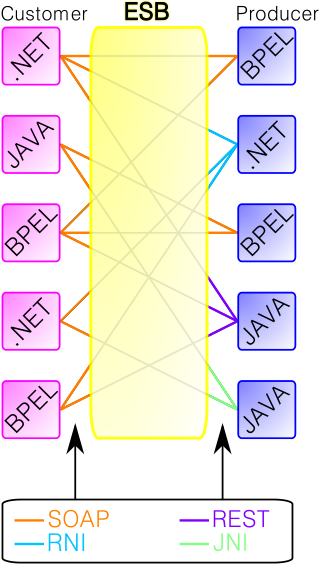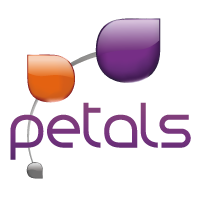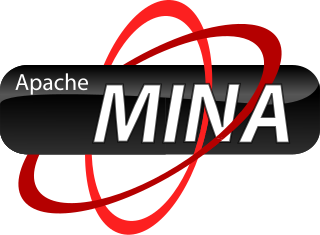
Eclipse is an integrated development environment (IDE) used in computer programming. It contains a base workspace and an extensible plug-in system for customizing the environment. It is the second-most-popular IDE for Java development, and, until 2016, was the most popular. Eclipse is written mostly in Java and its primary use is for developing Java applications, but it may also be used to develop applications in other programming languages via plug-ins, including Ada, ABAP, C, C++, C#, Clojure, COBOL, D, Erlang, Fortran, Groovy, Haskell, JavaScript, Julia, Lasso, Lua, NATURAL, Perl, PHP, Prolog, Python, R, Ruby, Rust, Scala, and Scheme. It can also be used to develop documents with LaTeX and packages for the software Mathematica. Development environments include the Eclipse Java development tools (JDT) for Java and Scala, Eclipse CDT for C/C++, and Eclipse PDT for PHP, among others.

An enterprise service bus (ESB) implements a communication system between mutually interacting software applications in a service-oriented architecture (SOA). It represents a software architecture for distributed computing, and is a special variant of the more general client-server model, wherein any application may behave as server or client. ESB promotes agility and flexibility with regard to high-level protocol communication between applications. Its primary use is in enterprise application integration (EAI) of heterogeneous and complex service landscapes.
Apache Wicket, commonly referred to as Wicket, is a component-based web application framework for the Java programming language conceptually similar to JavaServer Faces and Tapestry. It was originally written by Jonathan Locke in April 2004. Version 1.0 was released in June 2005. It graduated into an Apache top-level project in June 2007.
Java Business Integration (JBI) is a specification developed under the Java Community Process (JCP) for an approach to implementing a service-oriented architecture (SOA). The JCP reference is JSR 208 for JBI 1.0 and JSR 312 for JBI 2.0. JSR 312 was removed from the JCP balloting process on 17 Dec, 2010 by the submitters without being accepted.
Mule is a lightweight enterprise service bus (ESB) and integration framework provided by MuleSoft. It has a Java-based platform and can also act as broker for interactions between other platforms such as .NET using web services or sockets.

Google Web Toolkit, or GWT Web Toolkit, is an open-source set of tools that allows web developers to create and maintain JavaScript front-end applications in Java. It is licensed under Apache License 2.0.

IONA Technologies was an Irish software company founded in 1991. It began as a campus company linked to Trinity College Dublin had its headquarters in Dublin, and eventually also expanded its offices in Boston and Tokyo. It specialised in distributed service-oriented architecture (SOA) technology, its products connecting systems and applications by creating a network of services without requiring a centralised server or creating an information technology project. IONA was the first Irish company to float on the NASDAQ exchange. It was valued at up to US$1.75 billion at its peak. It was one of the world's 10 largest software-only companies, and around 30 new ventures spun out from it. IONA was sold to Progress Software in 2008.
IBM App Connect Enterprise is IBM's integration software offering, allowing business information to flow between disparate applications across multiple hardware and software platforms. Rules can be applied to the data flowing through user-authored integrations to route and transform the information. The product can be used as an Enterprise Service Bus supplying a communication channel between applications and services in a service-oriented architecture.

A message broker is an intermediary computer program module that translates a message from the formal messaging protocol of the sender to the formal messaging protocol of the receiver. Message brokers are elements in telecommunication or computer networks where software applications communicate by exchanging formally-defined messages. Message brokers are a building block of message-oriented middleware (MOM) but are typically not a replacement for traditional middleware like MOM and remote procedure call (RPC).
OpenESB is a Java-based open-source enterprise service bus. It can be used as a platform for both enterprise application integration and service-oriented architecture. OpenESB allows developers to integrate legacy systems, external and internal partners and new development in business processes. It supports a multitude of integration technologies including standard JBI, XML with support for XML Schemas, WSDL, and BPEL with the aim of simplicity, efficiency, long-term durability, and low TCO.
Fuse Mediation Router is an open source tool for integrating services using Enterprise Integration Patterns based on Apache Camel for use in enterprise IT organizations. It is certified, productized and fully supported by the people who wrote the code. Fuse Mediation Router uses a standard method of notation to go from diagram to implementation without coding.
Service Component Architecture (SCA) is a software technology designed to provide a model for applications that follow service-oriented architecture principles. The technology, created by major software vendors, including IBM, Oracle Corporation and TIBCO Software, encompasses a wide range of technologies and as such is specified in independent specifications to maintain programming language and application environment neutrality. Many times it uses an enterprise service bus (ESB).
JBoss Tools is a set of Eclipse plugins and features designed to help JBoss and JavaEE developers develop applications. It is an umbrella project for the JBoss developed plugins that will make it into JBoss Developer Studio.

Petals ESB is an open-source ESB developed by Linagora. It is a tool for implementing a service-oriented architecture (SOA). It is standard, modular, and physically distributed, to adapt to large-scale infrastructures.
JBoss Developer Studio (JBDS) is a development environment created and currently developed by JBoss and Exadel.
Java view technologies and frameworks are web-based software libraries that provide the user interface, or "view-layer", of Java web applications. Such application frameworks are used for defining web pages and handling the HTTP requests (clicks) generated by those web pages. As a sub-category of web frameworks, view-layer frameworks often overlap to varying degrees with web frameworks that provide other functionality for Java web applications.
IBM WebSphere Service Registry and Repository (WSRR) is a service registry for use in a Service-oriented architecture.

Apache ActiveMQ is an open source message broker written in Java together with a full Java Message Service (JMS) client. It provides "Enterprise Features" which in this case means fostering the communication from more than one client or server. Supported clients include Java via JMS 1.1 as well as several other "cross language" clients. The communication is managed with features such as computer clustering and ability to use any database as a JMS persistence provider besides virtual memory, cache, and journal persistency.

Apache MINA is an open source Java network application framework. MINA can be used to create scalable, high performance network applications. MINA provides unified APIs for various transports like TCP, UDP, serial communication. It also makes it easy to make an implementation of custom transport type. MINA provides both high-level and low-level network APIs.








